The informant is a military veteran who served for thirty seven years. He retired a two star major general, a veteran of World War II, Korea, and Vietnam. His decorations include the Distinguished Service Medal with oak leaf cluster, the Silver Star Medal, the Defense Superior Service Medal, the Legion of Merit with three oak leaf clusters, the Bronze Star Medal and the Purple Heart Medal with oak leaf cluster. He is a Master Parachutist and served in the 503rd Parachute Infantry and the 187th Regimental Combat Team.
This is a tradition practiced by the Army Rangers and it occurs upon completion of Ranger school. The informant recalls that once he had made the required amount of jumps out of a plane and fulfilled basic training requirements, he received this a pin similar to the one pictured below.
Protruding from the other side of the badge, opposite where the two stars are located, are two sharp rods which are meant to go through the uniform and be inserted into a safety catch on the inside of the shirt. When the informant was first presented with the badge, however, these safety catches were not used. Instead, the rods went through the uniform and the officer who put the pin on would strike the pin with his palm so as to puncture the skin, giving the new member “blood wings”
This tradition has been around for a long time, according to the informant, and is very meaningful. It occurs at a liminal moment, when one goes from being a trainee to an acknowledged Army Ranger. It is the culmination of great deal of hard work. The wound inflicted will leave a scar, symbolising the permanace of this position. Now, if they are ever questioned as to the legitimacy of their status as a Ranger, they can show the scars. Also, it makes the moment of graduation, which is a happy one, more memorable. When they see the scars, it will remind them of the moment they graduated. It is also a test of discipline and will power to withstand the pain of being jabbed in the chest by two sharp rods.

